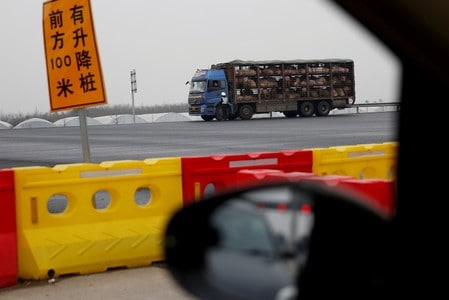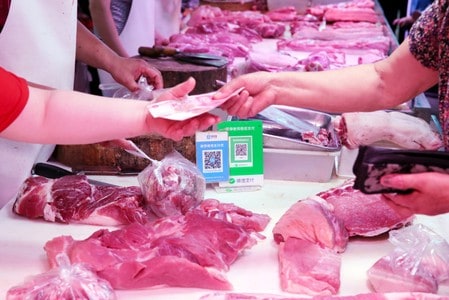By Dominique Patton and Hallie Gu
BEIJING (Reuters) – For pig trader Fang, the discovery of the deadly African swine fever in China last month has brought his once booming business to a sudden halt.
From northeast Liaoning province, Fang used to truck up to 600 pigs a day as far away as Guangdong, some 2,700 km (1,680 miles) to the south. But an outbreak of the highly contagious disease means transport of pigs out of Liaoning has been banned.
Fang, who declined to give his second name, said his 30 staff are on leave, and he doesn’t know when business will recover.
“I have been trading pigs for 16 years and have never seen anything like this,” he said.
China on Thursday reported its tenth case of the disease in just over a month. Efforts to control its rapid spread by banning transport of live hogs from and through infected areas has left traders idle, farm pens bursting with pigs, and slaughterhouses short of stock.
It has also pushed up pork prices in the country’s populous south as demand rises ahead of a week-long holiday in October, raised the prospect of imports, and underscored the limitations of a government push to promote livestock farming in the northeast cornbelt.
China is largely self-sufficient in pigs, but a major campaign to tackle farm pollution in recent years forced many piggeries in the south to close, while those in the northeast expanded to take advantage of plentiful grain and government support.
However, the south remains home to the bulk of slaughterhouse capacity, while consumers prefer freshly prepared pork, far and away China’s most popular meat. Experts estimate more than 30,000 pigs are trucked out of the country’s north each day.
Location of the 10 outbreaks of African Swine Fever in China since Aug 3, 2018: https://tmsnrt.rs/2PICxBx
TRANSPORT DILEMMA
The sweeping new transport restrictions in the wake of the outbreaks are now taking a growing toll on the annual $1 trillion industry.
At a breeding farm in Liaoning’s provincial capital Shenyang, around 8,000 piglets are stuck in pens, unable to reach customers outside the city, said a worker who declined to be identified.
“We have thousands of piglets that will soon be too mature to sell [to farms for fattening]. We have no choice but to raise them to hogs,” she said.
And while inventory builds in the north, slaughterhouses further south are struggling to find enough pigs. A worker at Zhouzhuang Slaughtering and Processing Co Ltd based near Wuxi in eastern Jiangsu province said the government this week banned sourcing pigs from outside the city.
“Wuxi doesn’t have any more pigs. In two or three days time, we’ll have nothing to slaughter,” he said.
The situation has pushed up the gap between prices in the north and prices in the south to as much as three times normal levels, said traders.
Average live hog prices in Liaoning fell to 12.02 yuan ($1.76) a kg on Tuesday, not enough to make a profit, said a Shenyang farmer surnamed Wang.
In southeast Zhejiang province however, which borders the cosmopolitan hub of Shanghai, prices spiked to 17.74 yuan a kg this week, up 23 percent since early August.
Swine fever divides China’s live hog market: https://reut.rs/2wKrXmz
IMPORT DEMAND
So far, Beijing has said that it expects only a short-term rise in pork prices.
National wholesale pork prices are at their highest since the Lunar New Year festival in mid-February, but are still well below levels when the government has preivously dipped into state reserves to calm the market.
However, Beijing has also warned the situation is difficult to predict. Many experts expect more cases and a further tightening of supplies in the south.
“China’s execution of biosecurity protocols has lots of flaws. The government is not capable of controlling the disease, and it will get harder and harder to process the situation,” said a Shanghai-based pig farm consultant who declined to be named.
With more cases emerging, there will be more restrictions on transport, he added, leading to tighter supplies.
That could lead to a pick-up in imports, said Pan Chenjun, senior analyst at Rabobank.
“I think given the soaring price in many regions, China will soon need to import more pork. There’s already a supply issue in the south and big cities like Beijing and Shanghai,” she said.
China imported about 2.3 million tonnes of pork and pork products last year, according to Chinese customs data, out of total consumption of about 55 million tonnes.
Soeren Tinggaard, vice president at Danish Crown, Europe’s biggest pork exporter, said the firm had not seen any signs of growing demand yet but was watching the situation closely.
Liaoning trader Fang said he expected business to improve if the transport curbs in Liaoning, initially put in place for six weeks, are lifted towards the end of the month.
However, with five new cases discovered in the past four days, experts say new restrictions are likely.
Even if they are lifted, slaughterhouses may still reject pigs from the north, lamented Shenyang farmer Wang.
Average meat consumption by country: https://reut.rs/2LgvA8e
The world’s top ten pork producers: https://reut.rs/2nUvFp7
(Reporting by Dominique Patton and Hallie Gu; additional reporting by Beijing Newsroom; editing by Richard Pullin)



